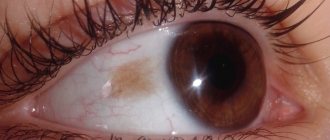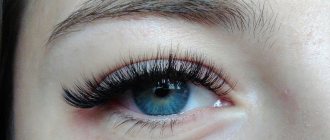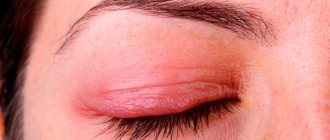Blindness in the eyes is an unpleasant symptom that can appear with a variety of diseases of the organs of vision and the cardiovascular system. The appearance of a veil may be accompanied by a loss of color and clarity of the image. Pathology can be of varying intensity and duration. These are diagnostic signs that help the doctor make a diagnosis. If the veil bothers you throughout the day, but does not interfere with distinguishing objects and colors, then it seems safe. In fact, this symptom warns of the development of a chronic disease. Which one depends on what symptoms accompany the appearance of the veil.
In more than 30% of cases, the cause of the pathology is a change in the retina. This is the part of the eye where the image received by the visual analyzer is converted into a nerve impulse. Therefore, you cannot ignore discomfort; you need to undergo an examination and find out the exact cause. Most ophthalmic diseases are easier to correct at an early stage of development.
At CELT you can get advice from an ophthalmologist.
- Initial consultation – 3,500
- Repeated consultation – 1,800
Make an appointment
Causes
In the vast majority of cases, the causes lie in defects in the organ of vision; much less often, the veil occurs due to cardiovascular or nervous diseases.
List of diseases accompanied by similar symptoms:
- Poor blood circulation in the retinal vessels. This is one of the most common ophthalmological pathologies. It is characterized by the fact that the veil appears for a while and then disappears. Its occurrence is sometimes accompanied by a number of other unpleasant symptoms: headache and weakness. Very often, the blood supply to the retina deteriorates due to a more serious disease: hypertension, thromboembolism, diabetes mellitus, or after an acute circulatory disorder.
- Cataract. Another disease that ophthalmologists encounter every day. Cataracts are a slowly progressing disease, so the veil does not appear immediately. Every month it becomes denser. This occurs due to the gradual clouding of the lens. Cataracts can be successfully treated: modern techniques make it possible to replace the lens and restore vision even in cases of advanced disease.
- Glaucoma. An attack of this disease can provoke a sharp rise in intraocular pressure. Visual impairment is accompanied by pain in the eye and head.
- Diseases of the cornea. The cornea is quite difficult to damage, so most often the veil appears against the background of inflammation or after a serious injury. Sometimes the layer of the cornea is destroyed as a result of sluggish dystrophy. In all cases, the appearance of a veil is associated with clouding of the cornea - transparency decreases and less light reaches the retina.
- Myopia. The veil accompanies only such a stage of the disease in which the normal configuration of the eyeball is disrupted. In addition to blurry vision, many other disorders appear.
- Retinal detachment or retinal dystrophy. They develop after an eye injury, less often – against the background of chronic diseases, for example, macular degeneration. Retinal detachment is caused by diseases of the endocrine glands, diabetes mellitus and rheumatoid arthritis, as well as all diseases associated with circulatory disorders. Sometimes dystrophy is congenital.
The cause is not always eye disease. A veil before the eyes also occurs against the background of a concussion. Therefore, when you receive a traumatic brain injury, the first thing you need to do is go to the emergency room, and only then consult an ophthalmologist.
Red veil before the eyes
It indicates hemophthalmos, a pathology in which blood flows into the vitreous body. Predisposing factors: hypertension, atherosclerotic lesions, diabetes mellitus, retinal dysfunction. Hemophthalmos is often associated with eye injuries. With this disease, a red veil appears and the organs of vision become blurred. If there is some blood in the vitreous, the patient sees floaters. The disease affects the quality of vision. Hemophthalmos caused by trauma is accompanied by discomfort in the eye.
Associated symptoms
Very rarely, the veil appears without accompanying symptoms, which will help to recognize which disease caused the illness. The clinical picture of these diseases is accompanied by symptoms:
Glaucoma:
- Sharp pain in the eye and head from the affected eye.
- Vision deteriorates sharply, sometimes so much that the patient cannot see the outlines of objects, only able to distinguish light.
- A veil appears before the eye.
- Nausea, often leading to vomiting.
- Redness of the eye.
Corneal damage:
- Tearing that does not stop for a long time.
- Sensation of a foreign body in the eye.
- Pain in the eyes, worse in the light.
- Decreased visual acuity.
Migraine:
- Pain that occurs in only one part of the head.
- The pain is throbbing or aching.
- Severe discomfort when exposed to loud noises, strong smells, or bright lights.
- Pain relief in darkness and silence.
- Nausea.
The appearance of a veil before the eyes may be accompanied by light flashes, spasmodic headaches, and glare. If unpleasant symptoms appear, you should consult an ophthalmologist. Even if you know what exactly triggered the attack. It is impossible to choose effective treatment on your own, especially for diseases such as cataracts and glaucoma.
Identifying the problem
When a veil appears before the eyes, a diagnosis is often made based on subjective sensations that the patient himself described when contacting a doctor. The patient may also be additionally referred for various diagnostic examinations that will help identify serious abnormalities in the eyeball.
To determine the cause of blurred vision, the following studies are carried out:
- Tonometry. The technique allows you to measure intraocular pressure at a given period;
- Biomicroscopy using a slit lamp;
- Various ophthalmological examinations, allowing you to look at the fundus of the eye and diagnose various structural disorders;
- Ultrasound examination of the eyeball.
Dangerous symptoms
There are a number of signs indicating the development of a life-threatening disease. If they appear, you should consult a doctor immediately:
- A sharp increase in body temperature.
- Numbness in one arm.
- Permanent weakness.
- The emergence of photophobia.
- The veil is accompanied by “floaters” before the eyes, which do not disappear for several minutes.
Almost all of the listed symptoms are characteristic of an acute circulatory disorder or an acute infectious process.
Diagnostics
If a patient consults a specialist with complaints of blurry vision, the ophthalmologist will carry out several basic diagnostic measures:
- visual eye examination
- retinal examination
- intraocular pressure measurement
- examination with a slit lamp or ophthalmoscope
Based on the results of the initial examination, it will become clear what additional examinations need to be completed.
If the appearance of unpleasant symptoms is caused by an injury, the doctor will definitely refer you to a traumatologist or neurologist, since the first step is to rule out fractures and serious brain damage.
Diseases such as glaucoma, cataracts, and retinal detachment often require surgery. Before this, you will have to undergo additional examinations and undergo standard tests.
Treatment
Treatment depends on what disease led to the appearance of the veil. Therapy begins only after a final diagnosis has been made.
If the cause is cataract, then the veil develops only in one eye and is associated with clouding of the lens. Treatment is aimed at restoring transparency - this can only be done through surgery to replace it. It is impossible to cure a clouded lens, so there is no point in conservative therapy.
Very often, patients are prescribed various drugs. This is a supportive treatment that includes vitamin and mineral complexes, vascular strengthening agents, and eye drops to help cope with unpleasant symptoms. The modern treatment regimen involves laser surgery, which is less painful than traditional surgery. During the procedure, an implant is installed in place of your lens.
An acute attack of glaucoma is easy to recognize on your own. For those who are prone to this disease, their doctor can give advice on what medications to use during an attack. In case of acute glaucoma, it is important to contact an ophthalmologist as quickly as possible. If the disease progresses, then treatment is only surgical.
For any retinal lesions, complex therapy is required, aimed both at preventing further vascular changes and at treating metabolic disorders that led to the development of the disease. If retinal detachment occurs, laser surgery is required. Soldering is performed using a laser beam. This is one of the simplest procedures - it is performed on an outpatient basis, takes no more than an hour, and is completely painless. In eight out of ten cases, vision is fully restored, in the remaining cases, a lasting improvement is achieved.
Why might this be a problem?
The feeling that you are looking at the world through cloudy and dirty glass is often caused by disorders in the retina when any deformation changes have occurred. As a result, the image formation occurs incorrectly. This symptom should not be ignored; it may be associated with serious pathologies of human vision. Only timely treatment will eliminate the problem without serious functional impairment. Sometimes the veil is not associated with problems with the eyes, but is caused by the development in the body of problems in the performance of the heart and nervous pathologies.
The feeling of fog or shroud can be caused by the following problems:
Remember that blurred vision is not always caused by problems with the organ of vision. If you hit your head hard and then experience an unpleasant symptom, most likely a concussion was caused during the impact. If a symptom appears in this case, you must immediately contact the emergency room, where you will be sent for a medical examination to make an accurate diagnosis.
Impaired vision clarity is often associated with the development of a stroke, in which the process of enriching the brain with blood and oxygen is disrupted. If a veil appears before the eyes due to a stroke, further treatment is carried out under the strict supervision of an ophthalmologist.
A haze before the eyes often indicates that malignant or benign tumors are developing in the brain area.
Taking certain medications on a regular basis can also cause problems (antidepressants, vascular medications, contraceptives, hormonal medications, cardiovascular medications). Blurred vision can be caused by allergies. In this case, the problem appears in the morning after sleep. If the eye is washed with water, not a trace remains of the veil. The problem is most likely due to the fact that somewhere near the bed there are objects that cause allergic reactions.
If a veil appears before your eyes after removing makeup with one or another cosmetic product, most likely your body is intolerant to some component of the product. In this case, getting rid of the veil is extremely simple - just choose a suitable and safe makeup remover.
Prevention
Prevention is the control of chronic diseases - even those that are not directly related to the organs of vision. For example, diabetes can lead to the development of glaucoma, cataracts, and retinal detachment. Therefore, the recommendations are the same for all patients: monitor blood pressure and sugar levels, maintain visual hygiene, see a doctor after injuries, and do not forget about preventive examinations. An annual examination can detect developing pathology at a very early stage, even before symptoms appear.
Prevention measures are especially important for older people. After the age of 55, the risk of developing ophthalmological diseases increases sharply and continues to increase every year.
For those who are younger, giving up bad habits, healthy eating and regular exercise will help preserve their vision.
You can check your visual acuity, undergo a full diagnosis using modern equipment and begin treatment at the CELT multidisciplinary clinic.
Useful video
White flies that appear after physical exertion or visual fatigue go away on their own and do not require specialized treatment. If spots are present even at rest, consultation with an ophthalmologist is necessary.
Author's rating
Author of the article
Alexandrova O.M.
Articles written
2031
about the author
Was the article helpful?
Rate the material on a five-point scale!
( 4 ratings, average: 4.00 out of 5)
If you have any questions or want to share your opinion or experience, write a comment below.
Our services in ophthalmology
The administration of CELT JSC regularly updates the price list posted on the clinic’s website. However, in order to avoid possible misunderstandings, we ask you to clarify the cost of services by phone: +7
| Service name | Price in rubles |
| Ultrasound scanning of the anterior segment of the eye | 1 000 |
| Comprehensive OCT examination of the retina (one eye) | 3 500 |
| Antiglaucomatous surgery for primary glaucoma stage 1 of the disease | 55 000 — 85 000 |
| Vitrectomy with cataract phacoemulsification without IOL cost | 90 000 — 130 000 |
All services
Make an appointment through the application or by calling +7 +7 We work every day:
- Monday—Friday: 8.00—20.00
- Saturday: 8.00–18.00
- Sunday is a day off
The nearest metro and MCC stations to the clinic:
- Highway of Enthusiasts or Perovo
- Partisan
- Enthusiast Highway
Driving directions











